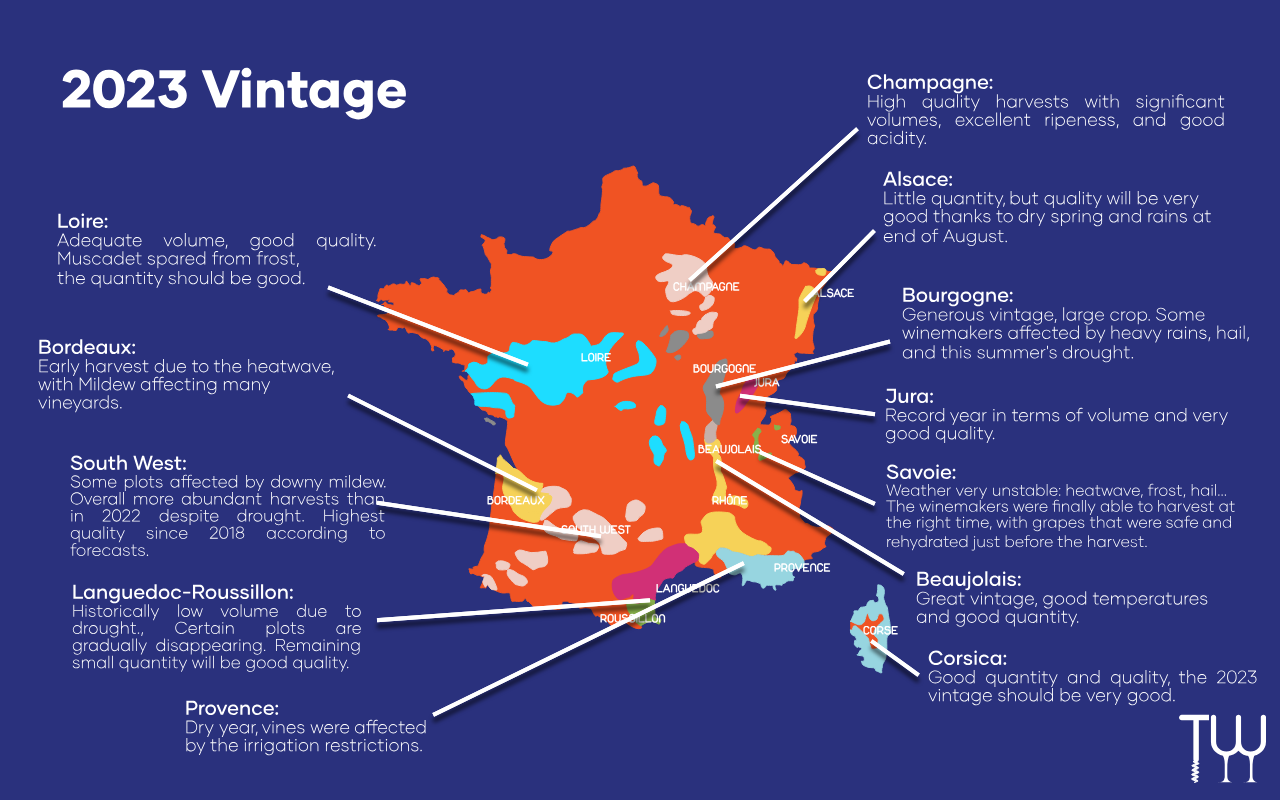
Heat waves in early July were followed by an exceptionally rainy end of the month before an intense heatwave in August. This was accompanied by drought in many regions. It took a great deal of expertise this summer to successfully carry out work in numerous vineyards. Overall, France fared better than its neighbor and competitor, Italy, which faced challenging conditions.
South-West :
Last July, concerns were raised about downy mildew-a disease affecting vineyards. The Gironde Chamber of Agriculture warned of significant damage, stating that 90% of the vineyards were affected. However, it appears that these concerns may have been exaggerated.
Antoine Médeville, Director of the Pauillac Oenoconseil Laboratory, is optimistic about the 2023 harvest, anticipating an abundance of grapes and the best since 2018.
It seems that downy mildew attacks were selective, affecting some plots more than others. Stéphane Gabard, President of the Bordeaux and Bordeaux Supérieur Union, confirmed this.
It is still too early to judge the quality, but professionals recall favorable weather conditions in August, with hot days and cool nights. This should contribute to high quality wines.
Bourgogne:
This year's harvest in Bourgogne is characterized by excellent quality and abundant quantity. Harvesting began on August 25th for sparkling wines (Crémants) and is ongoing for still wines. Despite unusual weather conditions, including scorching temperatures, winemakers are optimistic about the harvest. Some even had to remove grapes to maintain good yields. This harvest promises to replenish vineyard stocks after a 2021 year affected by frost.
Furthermore, collaboration with state authorities has resulted in solutions for vineyard worker housing, including creating a temporary village. This initiative could potentially be expanded across Bourgogne in the future.
Alsace:
In Alsace, the anticipated vintage is expected to be just sufficient enough to meet marketing plans set at around 970,000 hectoliters of wine. However, it is expected to be of high quality thanks to favorable weather conditions, including a dry spring, late August rains, and a return of sunshine. These conditions have allowed for maintaining a moderate grape load in the vineyards and excellent grape health. Harvesting began as early as August 23rd for Crémants, although occasional labor shortages may be encountered.
Languedoc:
In the Aude region, Jean-Marie Fabre, President of the National Union of Independent Winegrowers, raised serious concern, stating, 'We are facing vineyards on the brink of dying in some areas.'
Languedoc vineyards are experiencing an exceptionally small harvest due to the heatwave and water scarcity. High temperatures, reaching up to 43°C (109.4°F) during the day and not dropping below 26°C (78.8°F) at night for several days at the end of August, have led to significant crop losses, estimated at between 25% and 40% in some parts of Gard. This intense heat has caused rapid evaporation of grape moisture, significantly reducing their weight. Yields per hectare are expected to be low, which is concerning given the relatively low prices of wines in the region.
However, there is significant variation from one region to another. In some parts of Hérault and Gard, spring rains facilitated good ripening. Despite these challenges, some well-established appellations appear to be faring better.
Finally, industry stakeholders are calling for a reconsideration of prices charged by the restaurant industry, highlighting that the cost of some bottles is higher than the meal itself.
Champagne:
Champagne winemakers are anticipating a high quality harvest. White grapes destined for Chardonnay were harvested as early as September 2nd, displaying a high degree of ripeness and good acidity. This was despite some slight dilution from summer rains, which was offset by heat in September. Overall, weather conditions have been favorable for grape varieties, with no frost, significant hail, or diseases, although the harvest of black grapes posed more challenges due to rot development in August. Nevertheless, winemakers remain confident and plan to carefully sort to retain only the best clusters.
Loire:
According to Joël Forgeau from InterLoire, the Loire region, stretching from Nantes to Blois, including Anjou and Saumurois, seems to be on track to have a sufficiently abundant harvest in 2023. Downy mildew had a moderate impact and water stress wasn't excessive, which bodes well for the vintage's quality. Muscadet in Nantes was spared from frost, allowing for a production of approximately 300,000 hectoliters (about 7,926,000 gallons) to meet both domestic and export markets.
In 2021, early frost had reduced the harvest to 145,000 hectoliters (approximately 3,832,900 gallons), the lowest level in history. Stocks haven't been fully replenished since then. InterLoire, which supplies nearly 2.6 million hectoliters (approximately 68,492,000 gallons), has increased its presence in exports over the past two years. Out of 255 million bottles of Loire wines produced last year, 55 million were exported, accounting for 21% share with a goal set for 30% by 2030.
Jura:
While it's still too early to provide figures for harvest, it's safe to at least characterize this vintage as exceptional in quantity. Some estates are still processing grapes, which took longer to reach maturity than anticipated. Indications suggest an abundant and promising harvest.
Despite a fickle summer marked by temperature fluctuations and regular rainfall, vintners can breathe a sigh of relief. After facing a series of climate-related challenges that raised doubts about the future of their profession, they can finally focus on vinifying a harvest that has unfolded almost seamlessly.
Sancerre:
The red grapes lost more water than the Sauvignon, resulting in an increased alcohol concentration. Pinot Noir and Gamay were harvested earlier since their alcohol levels already reached 14 to 14.5%. Nonetheless, winemaker Fabrice Doucet is delighted with the juice's quality, which showcases aromas of fresh red fruits and hints of mint, without any jammy characteristics. He's satisfied with the preservation of acidity, as tartaric acid wasn't used as an energy source. Although there have been recent light rains, they don't seem to pose a threat to the grapes' health, which has remained very good thus far. There are no signs of botrytis, only a few cases of acid rot in certain parts of the vines that border the woods.
Savoie:
Across the 2,000 hectares in Savoie, harvest was graced with abundant sunshine in August and timely, lifesaving rains in September. Some parcels experienced significant losses due to adverse weather conditions throughout the year, but vineyards saw a silver lining.
Despite late frost, hailstorms, and scorching heatwaves, Savoie winemakers were ultimately able to harvest at the right moment. The grapes, once at risk, were saved and rehydrated just before the harvest. This remarkable turnaround proved to be a small miracle that rescued the 2023 vintage in the waning days of summer.



32 Rue Robert Mallet Stevens
30900 Nîmes - FRANCE
+33 (0)4.66.23.44.22

